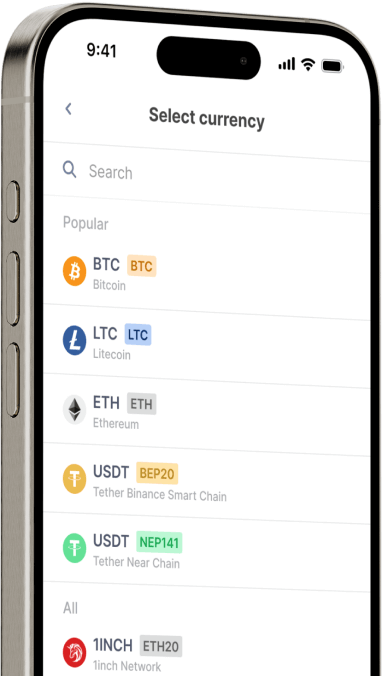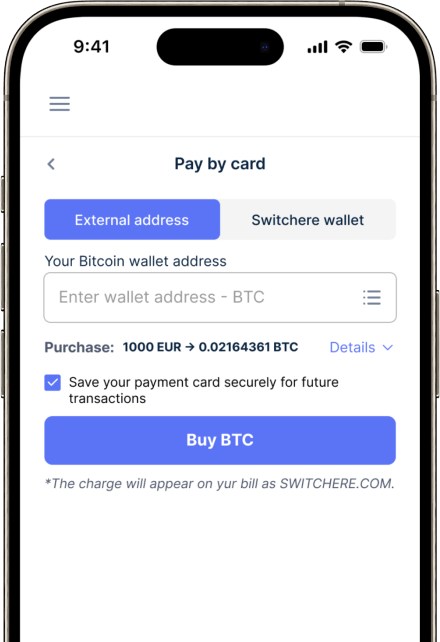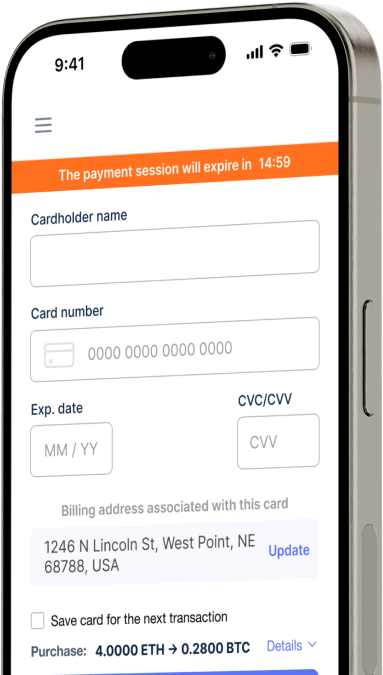Converter
Danish Krone (DKK) em CTC (CTC) instantaneamente
Compre CTC (CTC) com Danish Krone (DKK) facilmente na Switchere e beneficie-se de transações rápidas e seguras.
Sobre
CTC (CTC)
Creditcoin (CTC) é uma tecnologia blockchain fundamental projetada para resolver uma lacuna crítica no sistema financeiro global: a falta de um histórico de crédito universal e transparente. Seu principal objetivo é criar uma rede descentralizada para um mercado de crédito sem fronteiras, visando especificamente as populações sem acesso a serviços bancários. Ao registrar o desempenho de empréstimos em um livro-razão digital público, a Creditcoin fornece um mecanismo para que indivíduos e empresas construam um histórico de crédito verificável on-chain. Este ativo digital visa preencher a lacuna entre as finanças tradicionais e as aplicações DeFi, promovendo maior inclusão financeira ao tornar o crédito mais acessível e transparente em todo o mundo através de sua inovadora infraestrutura Web3.
O cerne do protocolo Creditcoin envolve a vinculação de acordos de empréstimo do mundo real, off-chain, à sua blockchain imutável. Esse processo cria uma prova objetiva de credibilidade que não é controlada por nenhuma entidade única. O token de utilidade nativo, CTC, é essencial para a operação do ecossistema. Ele é usado para pagar as taxas de transação necessárias para registrar transações de crédito, como solicitações e pagamentos de empréstimos, na cadeia. Além disso, o CTC pode ser utilizado para staking para aumentar a segurança criptográfica da rede. Essa abordagem única de integrar ativos do mundo real (RWA) na forma de crédito privado estabelece uma camada fundamental para a reputação on-chain e novos produtos financeiros.
Compre outras 150+ criptomoedas por Danish Krone (DKK)
Outras moedas para Danish Krone (DKK)
-
DKK a ZRX
-
DKK a 1INCH
-
DKK a AAVE
-
DKK a ACH
-
DKK a ALGO
-
DKK a TLM
-
DKK a ANKR
-
DKK a APE
-
DKK a NFT
-
DKK a API3
-
DKK a APT
-
DKK a ARPA
-
DKK a AUDIO
-
DKK a AVAX
-
DKK a AVAX
-
DKK a AXS
-
DKK a BADGER
-
DKK a BAL
-
DKK a BNT
-
DKK a BAT
-
DKK a BNB
-
DKK a BSW
-
DKK a BSV
-
DKK a BLUR
-
DKK a BONE
-
DKK a CTSI
-
DKK a CELR
-
DKK a CELO
-
DKK a CEL
-
DKK a LINK
-
DKK a CHZ
-
DKK a CHR
-
DKK a C98
-
DKK a COMP
-
DKK a CFX
-
DKK a PEOPLE
-
DKK a CVX
-
DKK a ATOM
-
DKK a CTC
-
DKK a CRV
-
DKK a DAI
-
DKK a DASH
-
DKK a MANA
-
DKK a DENT
-
DKK a DGB
-
DKK a DYDX
-
DKK a XEC
-
DKK a EOS
-
DKK a ETC
-
DKK a ENS
-
DKK a ETHW
-
DKK a FET
-
DKK a FIL
-
DKK a FLOKI
-
DKK a GALA
-
DKK a GNO
-
DKK a ONE
-
DKK a HBAR
-
DKK a HOT
-
DKK a HOOK
-
DKK a ICX
-
DKK a ILV
-
DKK a IMX
-
DKK a INJ
-
DKK a ICP
-
DKK a IOST
-
DKK a IOTX
-
DKK a JASMY
-
DKK a JST
-
DKK a KAVA
-
DKK a KCS
-
DKK a KSM
-
DKK a KNC
-
DKK a LDO
-
DKK a LQTY
-
DKK a LPT
-
DKK a LOOKS
-
DKK a LRC
-
DKK a LUNA
-
DKK a MKR
-
DKK a MASK
-
DKK a EGLD
-
DKK a ALICE
-
DKK a NEAR
-
DKK a XEM
-
DKK a NEXO
-
DKK a NOT
-
DKK a NMR
-
DKK a OKB
-
DKK a OMG
-
DKK a ONT
-
DKK a EDU
-
DKK a OP
-
DKK a OGN
-
DKK a CAKE
-
DKK a PAXG
-
DKK a PENDLE
-
DKK a DOT
-
DKK a POL
-
DKK a QTUM
-
DKK a QNT
-
DKK a RDNT
-
DKK a XRD
-
DKK a RVN
-
DKK a REN
-
DKK a RSR
-
DKK a RLC
-
DKK a RPL
-
DKK a SFP
-
DKK a SHIB
-
DKK a SKL
-
DKK a SXP
-
DKK a STND
-
DKK a STG
-
DKK a XLM
-
DKK a GMT
-
DKK a STORJ
-
DKK a STMX
-
DKK a SUSHI
-
DKK a SNX
-
DKK a USDT (Polygon)
-
DKK a USDT (AVAC)
-
DKK a USDT (BEP20)
-
DKK a USDT (ERC20)
-
DKK a USDT (SPL)
-
DKK a USDT (NEP141)
-
DKK a USDT (FA2)
-
DKK a USDT (TRC20)
-
DKK a USDT (JETTON)
-
DKK a XTZ
-
DKK a GRT
-
DKK a SAND
-
DKK a TFUEL
-
DKK a THETA
-
DKK a RUNE
-
DKK a TON
-
DKK a TUSD (BEP20)
-
DKK a TUSD (TRC20)
-
DKK a TWT
-
DKK a UOS
-
DKK a UMA
-
DKK a UNI
-
DKK a USDC (Polygon)
-
DKK a USDC (SPL)
-
DKK a USDC (OP)
-
DKK a USDC (BEP20)
-
DKK a USDC (AVAC)
-
DKK a USDC (ARB)
-
DKK a USDC (ERC20)
-
DKK a VET
-
DKK a VRA
-
DKK a WAXP
-
DKK a WOO
-
DKK a WLD
-
DKK a WBTC
-
DKK a WMINIMA
-
DKK a XDC
-
DKK a YFI
-
DKK a YGG
-
DKK a ZIL
Como comprar CTC (CTC)
Perguntas frequentes
-
O que o par de negociação DKK/CTC representa em uma exchange de criptomoedas?
O par DKK/CTC representa a taxa de câmbio entre a Coroa Dinamarquesa (DKK) e o Creditcoin (CTC). Ele permite que você compre CTC, o token nativo de um sistema de crédito baseado em blockchain, usando DKK. O Creditcoin é um projeto único de Ativos do Mundo Real (RWA) projetado para criar um histórico de crédito objetivo na cadeia para pessoas sem acesso a serviços bancários, rastreando o desempenho de empréstimos.
-
O que é Prova de Crédito (Proof-of-Credit) e como ela se relaciona com o valor da rede Creditcoin?
Prova de Crédito é o mecanismo de consenso da Creditcoin para verificar o desempenho de empréstimos. Ele permite que a rede registre um histórico de crédito imutável e objetivo na blockchain. Essa função central de criar uma rede transparente de relatórios de crédito para mutuários do mundo real confere ao CTC utilidade tangível no espaço de Ativos do Mundo Real (RWA). Essa utilidade, com o objetivo de servir os sub-bancarizados, é um fator chave do valor potencial de longo prazo para o token CTC.
-
Como a API da Gluwa aumenta a utilidade do token Creditcoin (CTC)?
A API da Gluwa atua como uma ponte crucial, fornecendo interoperabilidade entre a rede Creditcoin e outros serviços financeiros ou blockchains. Ela permite que credores fintech e outras plataformas se integrem facilmente ao sistema de crédito baseado em blockchain da Creditcoin. Essa integração perfeita pode impulsionar a adoção, aumentar o volume de dados de desempenho de empréstimos registrados na cadeia e, em última análise, aumentar o valor fundamental e a demanda pelo CTC como o token central deste ecossistema em crescimento.
-
Quais são os passos comuns para comprar CTC com DKK através de uma rampa de acesso fiduciária?
Para comprar CTC com DKK, primeiro você precisará encontrar uma exchange de criptomoedas que aceite depósitos em Coroa Dinamarquesa. Pode ser necessário concluir a conformidade com KYC/AML. Métodos de pagamento comuns em DKK incluem transferências bancárias em DKK ou compras com cartão de débito/crédito. Em muitas plataformas, você pode primeiro ter que trocar DKK por um ativo digital principal como USDT ou BTC e, em seguida, usar esse ativo para negociar por CTC no livro de ordens CTC/USDT ou CTC/BTC.
-
Que tipo de medidas de segurança são cruciais ao negociar o par DKK/CTC?
Ao realizar uma compra de ativo digital de DKK para CTC, sempre use uma exchange respeitável e regulamentada que cumpra as regulamentações europeias de AML. Ative a autenticação de dois fatores (2FA) em sua conta. Após a negociação, a melhor prática é retirar seu CTC da exchange para uma carteira digital privada e não custodial, onde você controla as chaves privadas. Para participações significativas, considere o uso de uma carteira de hardware para máxima segurança contra ameaças online.
-
Existem exchanges específicas conhecidas pela boa liquidez de DKK/CTC no mercado cripto nórdico?
Um par de negociação direto DKK/CTC é raro. Usuários na região nórdica geralmente usam exchanges europeias regulamentadas que aceitam depósitos em DKK via transferência bancária. O caminho comum é primeiro converter DKK para uma criptomoeda de alta liquidez como EUR, USDT ou BTC. Em seguida, você pode negociar em uma exchange global que lista o CTC contra esses pares. Sempre verifique o volume de negociação e a profundidade do livro de ordens para o par específico de CTC para garantir liquidez suficiente e minimizar a derrapagem em sua transação de blockchain.




